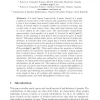Free Online Productivity Tools
i2Speak
i2Symbol
i2OCR
iTex2Img
iWeb2Print
iWeb2Shot
i2Type
iPdf2Split
iPdf2Merge
i2Bopomofo
i2Arabic
i2Style
i2Image
i2PDF
iLatex2Rtf
Sci2ools
GD
2004
Springer
2004
Springer
Layouts of Graph Subdivisions
A k-stack layout (respectively, k-queue layout) of a graph consists of a total order of the vertices, and a partition of the edges into k sets of non-crossing (non-nested) edges with respect to the vertex ordering. A k-track layout of a graph consists of a vertex k-colouring, and a total order of each vertex colour class, such that between each pair of colour classes no two edges cross. The stack-number (respectively, queue-number, track-number) of a graph G, denoted by sn(G) (qn(G), tn(G)), is the minimum k such that G has a k-stack (k-queue, k-track) layout. This paper studies stack, queue, and track layouts of graph subdivisions. It is known that every graph has a 3-stack subdivision. The best known upper bound on the number of division vertices per edge in a 3-stack subdivision of an n-vertex graph G is improved from O(log n) to O(log min{sn(G), qn(G)}). This result reduces the question of whether queue-number is bounded by stack-number to whether 3-stack graphs have bounded queue ...
3-stack Subdivision | GD 2004 | Graph G | Total Order |
| Added | 01 Jul 2010 |
| Updated | 01 Jul 2010 |
| Type | Conference |
| Year | 2004 |
| Where | GD |
| Authors | Vida Dujmovic, David R. Wood |
Comments (0)

